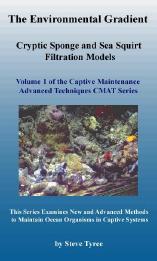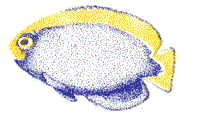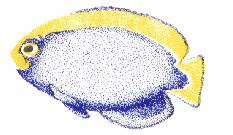|
Natural Filtering Capability of the Living Sponges
By Steve Tyree
While sponges are the most primitive and simplest of the multicellular
animals, they have achieved remarkable ecological success and possess an
incredible nutrient gathering capability. Sponges are aquatic animals that
occur in all oceans and have a wide distribution from tropical to temperate
to arctic regions. There are also a few freshwater species that inhabit
the ponds, lakes and streams in most areas of the world. They possess an
incredible ability to morph and adapt to differing environmental conditions.
This has allowed them to inhabit a wide variety of environmental niches
from shallow coastal waters to very deep ocean zones. In some Caribbean
locations sponges are more abundant than corals. They filter an incredible
quantity of water from which they acquire oxygen and nutrients. The outer
surface of a sponge is covered with inhalant pores where the ambient water
is drawn into the sponge. These pores represent why sponges have been called
the "Porifera" (Simpson 1983)(De Vos et. al 1991). Sponges have existed
on the planet longer than any other animal and they may represent a natural
method for controlling ambient bacterial and dissolved organic levels."
"The oldest animal skeletal fossil that has ever been found was a sponge
spicule. These first sponges actually inhabited the earth 500 million years
before the Tyrannosaurus dinosaurs evolved. About 600 million years ago,
sponges branched away from the main evolutionary animal tree. They began
to diversify into the thousands of sponge species that still exist today.
There has been no higher order animal that has evolved from the basic sponge
design. While sponges have existed on the planet, millions of new animal
species have evolved on separate and distinct branches of the evolutionary
tree. Most of these newly evolved animals became extinct as higher order
species evolved and replaced them. During this time, the earth's environment
has dynamically changed and experienced many catastrophes. These events
included great plagues, ice ages, volcanic disturbances and even huge meteoric
disturbances. Some of the more catastrophic events may have even blocked
planetary sunlight for months and possibly years. The species that could
not adapt to sudden changes in environmental conditions became extinct.
It has been estimated that 97 % of all species that have ever evolved have
become extinct. While these extinct species were failing to adapt, the
oldest and first animal to evolve, the sponge, has remained basically unchanged.
Its simple filtering system can be considered a functionally perfect design
and an engineering masterpiece. While all the other higher order species
on the planet have been adapting and evolving or not adapting and becoming
extinct, the sponge has remained defiant and prolific. It has not adapted
or evolved into a new higher order organism and has not become extinct.
It is defying the order of continuing evolution, while surviving all the
challenges that mother nature has presented it with. To date, it is perhaps
the most fittest animal that has ever inhabited the planet (Gammill 1997).
What gives the sponge this incredible ability to adapt to a changing environment
without adapting to a higher order organism or becoming extinct ?
"In some areas sponges have been found to play an extremely important
role to the ecological habitat. For example, on Caribbean reefs it has
been estimated that on the exterior slope between 25 and 40 m depth, sponges
are so abundant and active that in 24 hours they filter the equivalent
of the overlying water column (De Vos et. al. 1991). This means that the
dissolved organics and bacterial populations of this ambient water
are primarily consumed by the local sponge population. In the Bahamas,
there are sponge dominated structures that have been referred to as "sponge
reefs". These sponges act as sediment traps, sediment binders and also
promote inorganic cementation processes. This has established a rigid and
stable platform that other organisms such as gorgonians and about 10 species
of corals have attached to. On Jamaican reefs, at depths from 70 to 105
meters, massive calcareous sponges once thought to be extinct have been
found dominating reef surfaces (Tyree 1998)."
"The captive maintenance of sponges has historically been a difficult
task to accomplish. Even scientist studying sponges in laboratory setups
have had problems maintaining them in healthy conditions. Scientists have
concluded that sponges are delicate and sensitive organisms (Reiswig 1981).
Since the beginning of the reef keeping trend that promoted the captive
maintenance of invertebrates, the captive reef market has imported limited
numbers of live sponges. Prior to that time, sponges where incidental animals
that saltwater enthusiasts would occasionally try to maintain. Some of
these early sponges were probably sacrificed as food for marine angelfish.
Unfortunately, the long term survivability of many of these sponges
was initially very poor. These early systems were heavily artificially
filtered and imported sponges were also not being properly collected or
handled. This gave the sponge a label as being very difficult to keep.
This reputation is similar to how aquarist viewed early attempts to maintain
reef building stony corals in captivity. These corals are known for releasing
copious amounts of coral slime into captive systems. Long term success
with stony corals has been achieved by the utilization of advanced and
technically orientated artificial filtration systems. While utilizing these
systems we have learned that when properly maintained and handled, stony
corals can thrive in captivity. Thousands of aquarist around the world
are
either experimenting with coral farming or actively farming these corals.
It is hoped that this book can help the captive reef maintainer become
very successful with maintaining, growing and farming live sponges in captivity.
In fact, it can be very easy to have growing and thriving sponges that
are doubling in size every few months. They can grow much faster than stony
corals and can be farmed and utilized as integrated live filtration
components."
"The integration of live sponges into a captive system can vary quite
dramatically in scale. Some captive aquarist might just be attempting to
keep a few sponges in isolated locations within their main display reef.
Others might set up a small isolated area or refugia where conditions are
beneficial for sponge propagation. The most extreme integration occurs
when sponges are utilized as the primary filtration component for a captive
reef system. An emphasis is placed on allowing sponges to consume the bacteria
and dissolved organics that are produced by the typical organisms maintained
within captive systems. Captive systems that have sterilized and heavily
filtered environments should probably not integrate sponges into them.
Sponges in those systems will require food in the form of bacteria, dissolved
organics or plankton. Adding food to these systems to support the sponges
undermines the natural potential that sponges have for filtering the water.
It would be better to back off the non-natural filtration components as
sponges are added. They are a natural method to control pelagic bacterial
populations and dissolved organic concentrations. These capabilities should
be utilized by the captive aquarist and artificial food should not be required
to maintain sponges. The dissolved organics and bacterial levels of the
typical captive system can be controlled by the addition of sponges.
For aquarist that desire to maintain very large sponges in sterile systems
(not recommended by the author) artificial foods that could be utilized
include dissolved nutrients and live
phytoplankton or frozen micro-plankton. Artificial food particles need
to be smaller than 50 microns in diameter to be ingested by sponges. The
concept of establishing a completely natural based filtration system that
is based on establishing a wider gradient of environmental parameters.
A Captive maintainer employing such a system can utilize low light cryptic
organisms as natural filtration consumers."
CLICK
HERE for more information on
Steve
Tyree's DE Publishing - The Captive Oceans Series
  
|














